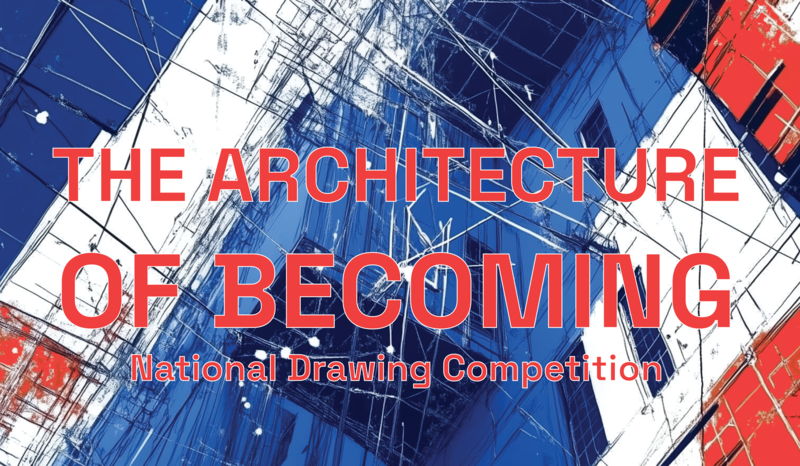Architecture
Faculty of Architecture
Latest news
Competition is open: "The Architecture of Becoming"

2025-02-13
Competition is open: "The Architecture of Becoming"
The community of the Faculty of Architecture of Vilnius Gediminas Technical University (VILNIUS TECH) invites students and recent graduates to take part in the annual architectural drawing competition, the winner of which will be awarded with a prize established by the travel agency BPC travel and will receive an invitation to hold a solo exhibition at the VILNIUS TECH Library. The competition is open until 24 March 2025.
The theme of this year's drawing competition proposes to imagine architecture and landscapes in movement, in transformation, in a process that prevents forms from becoming fixed, imovable and finally placed objects.
The concept of becoming is originating from the French philosophers Gilles Deleuze and Felix Guattari and is discussed in their book A Thousand Plateaus, 2004. Lithuanian phylosopher Audronė Žukauskaitė, who has examined it, argues that becoming is molecular: "<...> unlike a molar structure, which identifies and defines clear segments and surfaces, molecular becoming refers to interconnections and relations, it involves movement, movement, reorganisation" (2011).
The architecture of becoming has no aim, since movement is the aim. Movement is necessary in order for the human-made environment to form new assemblages. If movement is the ultimate aim, can we imagine an architecture of different speeds - fast or slow?
Although visionary architects of the 20th century also imagined mechanically mobile buildings (Archigram, Walking City), becoming takes place first and foremost at the level of thought, of ideas, of imagination.
The theme of becoming can be related to the need to break free from the constraints of architectural definitions, design methods and rules. The starting point for liberation can be the disjunctions between the architectural form, its uses (functions) and its social/cultural value. Such disjunctions open up artistic possibilities of linking different parts of the artificial environment and their meanings. One example is the project "The Manhattan Transcripts" by architect Bernard Tschumi.
Movement can lead to a loss of architectural coordinates, a lack of identity, urban voids, unfinished or abandoned buildings and sites that hide unrealised possibilities.
Transformation is also associated with architectural reconstruction. Such remodeling can be caused by the human desire to play, by human or natural destruction, by deliberate demolition, or by the power of time to change everything ( Lebbeus Woods, Filip Dujardin, Philipp Schaerer).
The disappearance of architecture as an object, its becoming blurred and indeterminate, can be caused by technologies that mediate between human and environment. For example, due to the shakiness, broken focus function, stroboscopic zooming an optical apparatus such as a telephone, a photo or film camera leads to a blur (see blured architectural photogtraps of iconic buildings by Hiroshi Sugimoto), while electronic and communication disturbances lead to image glitches. Or is it possible that in the contemporary world, so dependent on virtuality, the disappearance of the materiality turnes the architecture into a media screen?
The drifting of architecture and man-made environment can also be envisioned as process of "feminisation". This implies a profound shift in the identity of architecture away from the expression of power and towards the creation of nurturing, healing, safe spaces, attentive to the diversity of communities and individuals.
Meanwhile, architecture's becoming earth refers to a rethinking of its materiality in the context of geological, ecological processes (see drawings by Fei Fei Zhou).
One can also imagine scenarios of architecture becoming a machine - not only in the sense communicated by Le Corbusier. The architecture‘s becoming machine can be manifested through the impact of artificial intelligence resources on the creation and control of spaces (see films by Liam Young).
Grand prize is established by BPC Travel. The winner will have a possibility to present personal exhibition at VILNIUS TECH Library. Best authors will also get prizes from LAPAS Publishing house and VILNIUS TECH.
Organisers:
VILNIUS TECH Department of Architecture Fundamentals, Theory and Art. The curator of the competition is the artist and professor of the Faculty of Architecture of VILNIUS TECH, Audrius Novickas. Assisted by Assoc. Prof. Lilija Puipienė.
Participants:
The competition is open to students of all levels of architectural studies at Lithuanian higher education institutions and 2024 graduates of architecture studies.
Jury of the competition drawings:
The entries will be evaluated by a jury of professional artists and architects. The aim of this jury is to select the three artists who have submitted the most interesting and best drawings from among all the participants.
The judging criteria for the competition are: the relevance of the drawings to the theme of the competition, originality, conceptual clarity of the idea, the harmonious use of drawing tools and the aesthetic quality of the execution.
Methods and means of drawing:
The works must be drawn on paper by hand or by combining hand drawing with other graphic representation techniques such as collage or computer drawing.
Drawings may be created using a variety of drawing media such as graphite, charcoal, ink, marker, liners (rapitograph), brushes, feathers, etc.
Drawing size:
The maximum size of the drawing is 1x1m. This means that the drawing can be smaller.
Deliver drawings to the following address:
Department of Fundamentals of Architecture, Theory and Art
VILNIUS TECH Faculty of Architecture
Pylimo g. 26/1 Vilnius 01118
(or to be handed over to art teachers, VILNIUS TECH Architecture Palace, 4.15/4.16)
Deadline for drawings submission is 24 March 2025.
The parcel must be labled "For the Architectural Drawing Competition"
Exhibition:
The drawings submitted to the competition will be exhibited in the exhibition in the 4th floor ocorridor.
If you have any questions, please contact: crypt:YXVkcml1cy5ub3ZpY2thc0B2aWxuaXVzdGVjaC5sdA==:xx
+370 683 20159
The theme of this year's drawing competition proposes to imagine architecture and landscapes in movement, in transformation, in a process that prevents forms from becoming fixed, imovable and finally placed objects.
The concept of becoming is originating from the French philosophers Gilles Deleuze and Felix Guattari and is discussed in their book A Thousand Plateaus, 2004. Lithuanian phylosopher Audronė Žukauskaitė, who has examined it, argues that becoming is molecular: "<...> unlike a molar structure, which identifies and defines clear segments and surfaces, molecular becoming refers to interconnections and relations, it involves movement, movement, reorganisation" (2011).
The architecture of becoming has no aim, since movement is the aim. Movement is necessary in order for the human-made environment to form new assemblages. If movement is the ultimate aim, can we imagine an architecture of different speeds - fast or slow?
Although visionary architects of the 20th century also imagined mechanically mobile buildings (Archigram, Walking City), becoming takes place first and foremost at the level of thought, of ideas, of imagination.
The theme of becoming can be related to the need to break free from the constraints of architectural definitions, design methods and rules. The starting point for liberation can be the disjunctions between the architectural form, its uses (functions) and its social/cultural value. Such disjunctions open up artistic possibilities of linking different parts of the artificial environment and their meanings. One example is the project "The Manhattan Transcripts" by architect Bernard Tschumi.
Movement can lead to a loss of architectural coordinates, a lack of identity, urban voids, unfinished or abandoned buildings and sites that hide unrealised possibilities.
Transformation is also associated with architectural reconstruction. Such remodeling can be caused by the human desire to play, by human or natural destruction, by deliberate demolition, or by the power of time to change everything ( Lebbeus Woods, Filip Dujardin, Philipp Schaerer).
The disappearance of architecture as an object, its becoming blurred and indeterminate, can be caused by technologies that mediate between human and environment. For example, due to the shakiness, broken focus function, stroboscopic zooming an optical apparatus such as a telephone, a photo or film camera leads to a blur (see blured architectural photogtraps of iconic buildings by Hiroshi Sugimoto), while electronic and communication disturbances lead to image glitches. Or is it possible that in the contemporary world, so dependent on virtuality, the disappearance of the materiality turnes the architecture into a media screen?
The drifting of architecture and man-made environment can also be envisioned as process of "feminisation". This implies a profound shift in the identity of architecture away from the expression of power and towards the creation of nurturing, healing, safe spaces, attentive to the diversity of communities and individuals.
Meanwhile, architecture's becoming earth refers to a rethinking of its materiality in the context of geological, ecological processes (see drawings by Fei Fei Zhou).
One can also imagine scenarios of architecture becoming a machine - not only in the sense communicated by Le Corbusier. The architecture‘s becoming machine can be manifested through the impact of artificial intelligence resources on the creation and control of spaces (see films by Liam Young).
Grand prize is established by BPC Travel. The winner will have a possibility to present personal exhibition at VILNIUS TECH Library. Best authors will also get prizes from LAPAS Publishing house and VILNIUS TECH.
Organisers:
VILNIUS TECH Department of Architecture Fundamentals, Theory and Art. The curator of the competition is the artist and professor of the Faculty of Architecture of VILNIUS TECH, Audrius Novickas. Assisted by Assoc. Prof. Lilija Puipienė.
Participants:
The competition is open to students of all levels of architectural studies at Lithuanian higher education institutions and 2024 graduates of architecture studies.
Jury of the competition drawings:
The entries will be evaluated by a jury of professional artists and architects. The aim of this jury is to select the three artists who have submitted the most interesting and best drawings from among all the participants.
The judging criteria for the competition are: the relevance of the drawings to the theme of the competition, originality, conceptual clarity of the idea, the harmonious use of drawing tools and the aesthetic quality of the execution.
Methods and means of drawing:
The works must be drawn on paper by hand or by combining hand drawing with other graphic representation techniques such as collage or computer drawing.
Drawings may be created using a variety of drawing media such as graphite, charcoal, ink, marker, liners (rapitograph), brushes, feathers, etc.
Drawing size:
The maximum size of the drawing is 1x1m. This means that the drawing can be smaller.
Deliver drawings to the following address:
Department of Fundamentals of Architecture, Theory and Art
VILNIUS TECH Faculty of Architecture
Pylimo g. 26/1 Vilnius 01118
(or to be handed over to art teachers, VILNIUS TECH Architecture Palace, 4.15/4.16)
Deadline for drawings submission is 24 March 2025.
The parcel must be labled "For the Architectural Drawing Competition"
Exhibition:
The drawings submitted to the competition will be exhibited in the exhibition in the 4th floor ocorridor.
If you have any questions, please contact: crypt:YXVkcml1cy5ub3ZpY2thc0B2aWxuaXVzdGVjaC5sdA==:xx
+370 683 20159
-
- Page administrators:
- Agnė Vėtė
- Karolina Kardokaitė
- Ugnė Daraškevičiūtė


